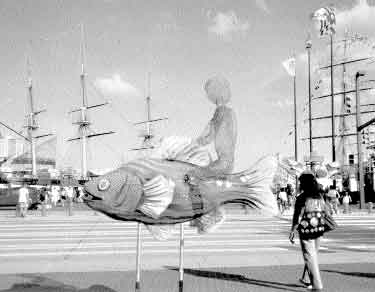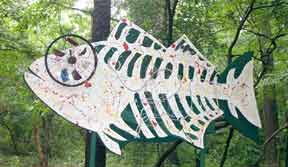|
|
 In AA County, Send a Kid Back to School with a Full Book Bag In AA County, Send a Kid Back to School with a Full Book Bag
Back to school time is exciting for most children. It’s a time to get new clothes, shoes, notebooks and pencils. There is nothing quite the same as organizing your new school supplies in your backpack for that first day of class.
But for many children in Bay Country, family finances don’t allow for that big back-to-school shopping spree. Schools send home lists of required supplies - including composition books, rulers, paper, pencils, school boxes, crayons - that many families just can’t afford.
Imagine being a child walking into school that first day with nothing in hand to start your learning.
Ten years ago, the Anne Arundel County Department of Social Services started a program to fill the school bags of those children. Partnering with the Board of Education, Social Services matches children with donors to make sure each child starts school with the right materials.
All 7,000 kids on the free lunch program are technically eligible, but “if we reach 3,500, we fell we’ve made a substantial dent in the need,” says Christine Poulsen of the
Department of Social Services. The program serves all elementary schools in Anne Arundel County.
Calvert County supplements its PTA and school resources with several charities - Trinity Church, Smile Inc. and a drive coordinated by Channel 9, says Sharon Burcham of the Calvert County School Board.
In Anne Arundel County, “the program has worked really well,” says Poulsen. Matching charitable supply shoppers to schools last year bought 3,000 elementary school children all the supplies they needed to start the school year.
By the last week of summer vacation this year, 2,000 children had been matched, so there’s still room for more help. School opens August 27, but there’s still time and need for cash donations, which will be turned into gift certificates. Send yours to the “Back to School Fund,” 80 West St., Annapolis, 21401.
- Hanne Denney
 Annapolis Goes African Annapolis Goes African
Five-month-old Sage Polee and father Henry danced to the music at this year’s Kunta Kinte Heritage Festival in Annapolis.
photograph by S.A. Kalinich
Once again the Kunta Kinte Heritage Festival transformed Annapolis into an African-rooted festival marketplace.
In August air thick and wet enough to warrant scuba gear, 10,000 people some in vivid dashikis, djellebas and other African garb strolled among festival tents that transformed the northern hillside of St. John’s College into a series of African villages.
Since 1989, more than 125,000 people have trekked to Annapolis for the annual celebration of African American, African and Caribbean culture. Named for author Alex Haley’s ancestor and the title character of his watershed book and TV series Roots, the festival brings together a mosaic of individuals and organizations.
It also helps raise money for the non-profit, Arnold-based Kunta Kinte Celebrations Inc., which sponsors scholarships, workshops, educational partnerships and a summer arts camp hosted by the Chesapeake Children’s Museum and the Banneker-Douglass Museum.
Annapolis native and Banneker Museum volunteer Brenda J. Lindsey traveled the globe before resettling in her home town four years ago. For her, the festival is a reunion with childhood friends.
As she talked, Lindsey nodded unconsciously to the bass beat of a Gospel group on the main stage. The lead singer asked the musical question “Is anybody grateful?” Lindsey grinned at that, glad to be back.
Nearby, a duo danced on the edge of the crowd: Sage Polee, a tiny, laughing, five-month-old in the arms of her dad Henry. “She likes the music,” her father said as he bounced his petite partner in a circle. “It’s the key to the soul.”
In the Arts and Crafts Village, vendors plied a kaleidoscopic assortment of goods ceramics, baskets, silver and gold jewelry, ebony carvings and furniture, kente-cloth and batik clothing and artwork, including paintings that upon closer inspection turned out to be intricate banana-leaf collages.
James LeCruise and partner Robin Jackson stood under a sign imprinted “Represent History.” Their product: T-shirts, caps, pins, books about two historic, segregated military groups, the post-Civil War Buffalo Soldiers and the Tuskegee Airmen of World War II.
Donald Smith had bought a T-shirt and cap emblazoned with the motto and name of the 10th Cavalry Buffalo Soldiers.
“I liked their slogan,” he said,“ ‘Ready and Forward’.”
Over in the Educational Village, costumed re-enactors from the Baltimore Buffalo Soldiers told about the all-black Army units formed in 1866. Native Americans gave the soldiers their name, after the sacred buffalo, because of the soldiers’ affinity to the land and their hair’s resemblance to the bison’s wool coat.
Jerome Hall is one of the more than 50 members of the Baltimore group, itself one of 26 chapters in the national organization, The 9th and 10th Horse Cavalry Association. Even though he’d been a military man for more than 30 years, Hall said he had never heard of Buffalo Soldiers until he joined the Baltimore chapter in 1998.
That’s when he discovered the unit he’d served with in Korea had been a regiment of the Buffalo Soldiers until 1944, when the segregated units were disbanded.
Meanwhile, out on the impromptu midway, people strolled and noshed on red beans and rice, fish, Jamaican jerk chicken, funnel cakes, gumbo and crab cakes.
At one booth, Wallace Williams, Enid Lee and Fred Foreman toiled over a hot barbecue to raise funds for the Maryland Forward kids’ summer education program at First Baptist Church in Annapolis.
During the two-day festival, members of the Washington Street church had roasted nearly 70 pounds of pulled beef and 12 dozen ears of corn-on-the-cob, said Foreman, chairman of the Laymen’s League. Even with the gray weather and lighter crowds this year, he said, the church had sold about 70 percent of its fare by late Sunday afternoon.
Kunta Kinte Celebrations Inc. holds a ceremony Sept. 29 at Annapolis City Dock commemorating the enslaved African’s 1767 arrival in Annapolis: 410/349-0338. www.kuntakinte.com.
- S.A. Kalinich
 In Calvert, 20th Cancer Gala Nears $250,000 In Calvert, 20th Cancer Gala Nears $250,000
The August moon - two days shy of full - was good enough. As were the champagne and the lobster, the martinis and the roast beef. The only thing wrong with the desserts was their disappearing act. And if the night wasn’t sultry enough to steam the 1,800 revelers dining, drinking and dancing at Rod ’n’ Reel, nobody complained.
All in all, Calvert County’s 20th annual Celebration of Life was good enough to raise a quarter of a million dollars to fight cancer in 2001. It was good enough to show that life is sweet despite the long shadow of sorrow. It was good enough to prove Bay Weekly readers absolutely right in naming Cancer Gala the Best Bay Fundraiser.
“We sat down with the lady from the Calvert County Unit of the American Cancer Society and gave her $235,000, with more to come,” said Mary O’Dell, who has chaired of the gala committee for six years. “Without our sponsors and volunteers, we couldn’t make this money. We’re so lucky in this small county to have so many people so generous.”
For Rod ’n’ Reel owner Gerald Donovan, the man behind the gala, it was “so overwhelming to go from $192,000 to what I’m sure will be over $250,000. After all these years, to go over $200,000, it’s like, what will we do next year,” he said.
Gala 2001 chair Kathy Milor attributed her success in breaking the $200,000 barrier to “people and corporate sponsors who were close to my husband.” Former firefighter Ron Milor, who died of cancer last September, was a labor union leader and Maryland’s chief labor contract negotiator. “Ron fought a hard battle,” Milor said. “I think people did this in his memory.”
Calvert County benefits directly from the Gala, with almost 40 percent of those thousands staying local. Programs begun with Gala help in Calvert include Road to Recovery, where cancer patients are driven to and from treatments by volunteers, and Look Good … Feel Better, where cosmetologists help female survivors redefine their beauty.
Calvert benefits locally from research nationally. “The strength in research dollars is through putting them collectively together,” said Peggy Morgan, American Cancer Society’s Calvert County liaison. The American Cancer Society spends $100 million annually to advance research.
In 20 years, Calvert’s Gala has contributed $1 million to the fight. “In our Mid-Atlantic Division,” said Morgan, “this is the largest per-capita fundraiser.”
- SOM w/Amanda Lofton
 Strange Large Fish Invade Downtown Baltimore Strange Large Fish Invade Downtown Baltimore
They’re everywhere. They’re everywhere!
Strange large fish have been sighted on the streets of Baltimore. Most are some six feet long, three feet high and a foot wide.
They are said to belong to the species Ichtayaerius baltimoris, or aerial fish from Baltimore. There is a great deal of variation in the genetic makeup, for in color and texture the fish vary widely and brightly. The attribute they share is the ability to produce goofy smiles and even cries of delight from passers by.
Under no circumstances should anyone attempt to ingest any portion of these creatures. Besides being overly crunchy, they are rumored to be protected by the local constabulary.
The plot that lead to the invasion of these finny beasts is said to have been hatched by Leslie Landsman, advocated by Baltimore City Councilwoman Catherine Pugh and endorsed by Mayor Martin O’Malley himself. It may have originated in Chicago, which experienced a similar invasion of cows in 1999.
As many as 200 of these soggy brutes were spawned under the watchful eye of Steve Weitzman at his studio. Individual fish were then allowed to fall into the hands of local artists, who practiced gruesome genetic experiments on these innocent creatures.
Fortunately, a plan is in the works to save this rare and varied tribe from extinction. In the autumn when the air cools, the fish tend to slow down enough to be captured. They will be auctioned to good homes at the newly renovated Walters Art Museum on November 17. Proceeds will benefit several local youth programs: MACAC City Grants Program, Baltimore City School of Fine Arts Program and the Mayor’s initiative to wire all city classrooms.
If you harbor a desire to lend your energies for the salvation of these innocent animals, or if you desire more in the way of knowledge, you may find what you seek at www.baltimorefish.org. To find these eclectic creatures in their habitats, click maps and check out the the “O-fish-al-finder.”
- Christopher Jensen
 Not the Only Fish in the Bay Not the Only Fish in the Bay
The fish that have taken up residence in the Baltimore harbor aren’t the only land-dwelling species around. They bear an uncanny resemblance to a trio of fish that inhabit a cozy copse at Solomons’ Annmarie Garden.
Annmarie Garden, Calvert County’s eight-year-old outdoor art museum, seasons 30 woodland acres with artful surprises. During a reflective walk through the wooded paths, you might see a family of deer visiting a cluster of limestone and tile figures in one of 14 thematic “rooms.” You might emerge from the shadowy woods into the open-air Council Ring,” a stone amphitheater in the heart of the park.
Or you might happen upon larger-than-life fish.
Just outside the “Generations Room,” up the gully from a sometimes-running drainage creek, the small school of big fish perch at the top of five-foot poles, their woodsy habitat dotted by bright sunlight.
Identical in shape and basic make-up, the family’s plywood bodies are all cut from the same four-by-eight frame. Their other traits identify their individual characters, from bare-bones silhouette to recycled-can scales. One fish follows the next in an evolutionary march out of the creekbed and over the terrain toward the walking path.
The school is precariously poised under the tangled line of a 10-foot tall fly-fishing rod, cast from the opposite side of the path.
The 18-inch fly at the end of the line is tangled in tree branches, as flies often are, so these fish are more likely to catch your eye than to get caught themselves. Which is the intent of Annapolis artist D.H. Banker, who helped her class envision the “large-scale” project.
“We liked the idea of the fish coming up out of the creek, in a sort of evolutionary movement,” explained Banker. “The one farthest into the woods is a skeletal shell of a fish, the middle one is a silhouette, and the one closest to the path is the most complete.” Complete for this fanciful swimmer means soda-can scales, venetian-blind-fins, and a circular saw blade for eyes.
“Plus, fish reflect something important about Southern Maryland; they’re part of the economy, the way of life around here,” said Banker, whose class used a rockfish skeleton as a model for one of the pieces.
But they’re not specifically rockfish-influenced, Banker insists. They’re an invasive species, imported by Annmarie Garden Director Jennifer Draxton, who convinced Banker to work with her students in the garden after seeing her sculptures at an art festival.
Banker’s class took over six months to design and build the fish in the basement of one student’s home before moving them to their garden habitat.
Unlike their urban cousins, the Baltimorians, who will be auctioned away in November, these lucky fish may have a permanent home at Annmarie Garden.
“They were only supposed to be there for a year,” said Banker, “But the park liked them so much, they’ve kept them for five.”
- Rachel Presa
Way Downstream …
In West Virginia, you may need to decide whether to fish or ski. The scenic Blackwater River was named one of the four most endangered trout streams in America by the Federation of Fly Fishers. The Montana-based group blamed mining and development associated with the Canaan Valley ski resorts …
In Florida, the man who instilled fear of sharks in the public is doing his best to preserve them. Peter Benchley, author of Jaws, which sold 20 million copies, is the new spokesman for the University of Miami’s Center for Sustainable Fisheries …
In London, a puny gibbon ape tossed burly Hulk Hogan out of the ring. It happened when a judge last week told the World Wrestling Federation that it had violated an agreement with World Wildlife Fund to scale back its use of the letters WWF …
Our Creature Feature comes from New York, where workers at a United Parcel Service center got quite a surprise when they investigated why a box was leaking.
It was a big box, and that was a good thing, because inside was a thrashing, five-foot-long alligator that had been sent from Atlanta, the New York Times reported. The gator never made it to an address in Brooklyn, though; it was being cared for at an animal shelter, where it was said to be thinking out of the box.
Copyright 2001
Bay Weekly
|